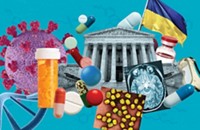Advertisement
Grab your lab coat. Let's get started
Welcome!
Welcome!
Create an account below to get 6 C&EN articles per month, receive newsletters and more - all free.
It seems this is your first time logging in online. Please enter the following information to continue.
As an ACS member you automatically get access to this site. All we need is few more details to create your reading experience.
Not you? Sign in with a different account.
Not you? Sign in with a different account.
ERROR 1
ERROR 1
ERROR 2
ERROR 2
ERROR 2
ERROR 2
ERROR 2
Password and Confirm password must match.
If you have an ACS member number, please enter it here so we can link this account to your membership. (optional)
ERROR 2
ACS values your privacy. By submitting your information, you are gaining access to C&EN and subscribing to our weekly newsletter. We use the information you provide to make your reading experience better, and we will never sell your data to third party members.
Science Communication
On behalf of C&EN, best wishes for a happy and healthy 2022
by Bibiana Campos-Seijo
December 17, 2021
| A version of this story appeared in
Volume 99, Issue 45
And so 2021 ends. Another pandemic year—our second—is finally over, and I wish I could say the same for the pandemic itself. The discovery of Omicron, another SARS-CoV-2 variant, at the end of November brings yet more uncertainty.
Omicron, a highly mutated form of the virus, is expected to cause a surge of infections and become the dominant variant soon, according to health officials. Tedros Adhanom Ghebreyesus, director general of the World Health Organization, said at a press conference, “Omicron is spreading at a rate we have not seen with any previous variant.” But there are suggestions that it causes less-severe symptoms. Nevertheless, its emergence put the world on red alert, and countries have once again closed their borders and restricted people’s movement.
In my editorial of 1 year ago, I asked, “Could 2021 possibly be worse [than 2020]?” and the answer has not turned out to be a resounding no. It’s more of a timid “2021 has been marginally better,” at least if you live in the US. There, during 2021, any adult who wanted to be vaccinated had access to the vaccine and booster. And at the end of October, the US Food and Drug Administration gave an emergency use authorization for children aged 5 to 11 to also receive the Pfizer-BioNTech vaccine—a move that caused parents, caregivers, educators, and school staff to breathe a big sigh of relief.
Testing has also become more available, helping prevent the spread of COVID-19 and allowing infected individuals to seek treatment earlier, reducing the need for hospitalizations.
This year was also marked by a job market full of ups and downs. The hiring freezes we saw in 2020 are long gone, and industries such as transportation, leisure and hospitality, manufacturing, and others have rebounded. But people are also resigning from their jobs in record numbers—a phenomenon dubbed the Great Resignation or the Big Quit that is being attributed to pandemic-related burnout, aversion to returning to the office after almost 2 years of working remotely, and a shift in workers’ priorities and values toward improved work-life balance and greater flexibility.
In summary, during 2021, the headlines were once again dominated by the pandemic just as they had been in 2020. As is traditional, at C&EN we have dedicated our last two issues of the year to look back on the preceding 12 months and reexamine the most significant and interesting developments in chemistry. Some are COVID-19 related, but many are not, and I invite you to take a look.
For example, in our Year in Pharma issue, which was published Dec. 6, we review new applications of messenger RNA technology that received investment in 2021, as well as new and promising types of therapies, such as psychedelic drugs and gene-editing technologies, that C&EN will be watching in the months and years to come.
In C&EN’s Year in Chemistry issue, we cover the research trends we observed in 2021 (page 38) and highlight a selection of the delightful discoveries that caught the eyes of C&EN editors (page 36). We also asked a group of experts to look ahead to 2022 and provide an analysis of what to watch for (page 46). And, as is now traditional, we include a rundown of “the coolest compounds unrelated to COVID-19” that were reported in 2021 (page 32).
C&EN’s selection of the molecules of the yearis a compilation of the most interesting compounds that made it into the scientific literature in the past 12 months. For the past few weeks, readers have had the opportunity to review the selection and vote for their favorite. Infinitene, a molecule made up of 12 fused benzene rings, became the top choice, obtaining nearly 39% of the votes.
Please note that this is the last issue of 2021. We are taking a short break—you’ll next hear from us Jan. 3.
On behalf of C&EN, best wishes for a happy and healthy 2022.
Views expressed on this page are those of the author and not necessarily those of ACS.



Join the conversation
Contact the reporter
Submit a Letter to the Editor for publication
Engage with us on Twitter